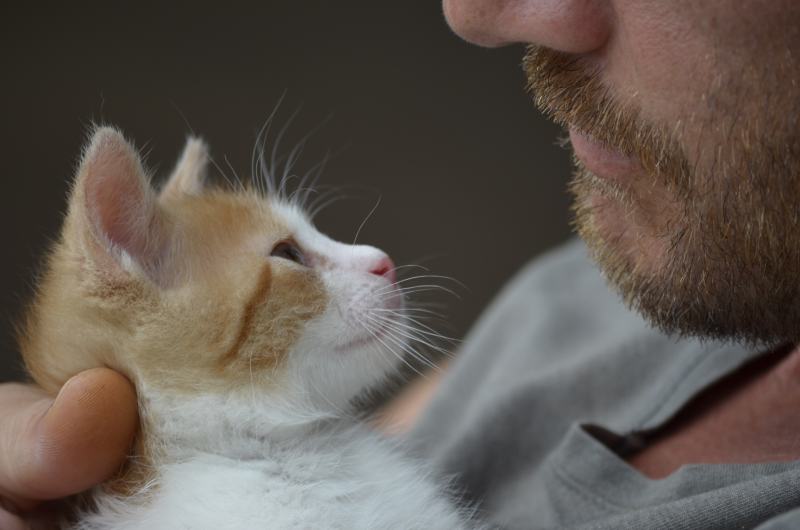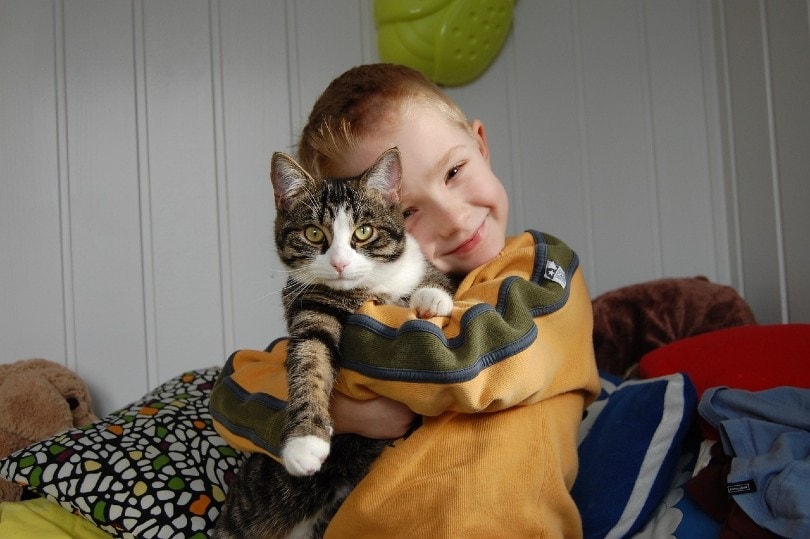How to Help Cats & Children Bond: 12 Expert Tips
Updated on

If you’re bringing home a new cat to your kids or children will be invading your cat’s space soon, it’s essential that you prepare both the children and your cat. Many cats prefer a certain amount of peace and quiet, and we know how boisterous children can be!
Here are several tips that should help this transition go more smoothly. If you already have a cat and children sharing the home but you want them to form a stronger bond, that’s covered too!
The 12 Tips to Help Cats & Children Bond
1. Shop for Cat Supplies
If you bring your child with you to purchase supplies for your cat, it makes them feel more involved in the decision-making. This can be for food, bowls, and fun toys.
If they are old enough, talk about what a cat needs to keep them healthy and happy. Let them pick out a toy that encourages interaction, like a feather wand.
2. First Impressions Are Everything
If you’re bringing home a new cat, ensure that the house is quiet and not too busy. Keep them in the carrier for a while in a quiet room, and let them out to explore the space when they seem ready.
You can start the introductions once your cat seems comfortable (which might be a few hours to a few days). Your child should offer their hand for the cat to sniff, and if the cat seems calm, they can gently and slowly pet the cat.
This process will take a while, and a parent or adult should always supervise these interactions, particularly if the child is still quite young.

3. Don’t Force It
If you are introducing your cat and children to each other, but your cat is struggling to run away or seems overly nervous, don’t force the interaction. Your cat will only associate negative feelings when around the child and likewise if your child is nervous around the cat.
Bonding definitely takes time and patience, and even just having the cat and child in the same room but not interacting will eventually help form a stronger bond.
4. Name the Cat
If this is a new cat, discuss possible names for the cat as a family. It’ll be even better if your child comes up with a great name that everyone likes. This can help strengthen the emotional bond between the child and the cat.
Even if they come up with a weird or silly name, it’s worth it if your child develops a stronger attachment to the cat when using the name of their choice.

5. Teach the Children How to Handle the Cat
It’s important that only older children handle the cat. Toddlers aren’t usually known for their gentleness, and the only way to build a bond between a cat and a child is for the cat to feel safe.
Before bringing home the cat, you must teach your children the best way to interact with the cat. They need to understand that cats and kittens are not toys but living, breathing animals that can feel scared and be easily hurt unless treated gently.
Tell them how to understand the cat’s body language, which can let them know when the cat is happy, scared, or angry. Also, teach them the best way to pick up your cat.
6. Slow & Steady Wins the Race
The best way to build a cat’s trust is by letting them come to you. Children tend to be fairly impatient and live in the moment, so it can be challenging to ask them to wait patiently. But to build trust between them and the cat, it’s vital that they understand this.
Have your child sit patiently and wait for the cat to approach them. This gives the cat more control, which can only make the bond grow stronger between them.

7. Create a Routine
Make the cat a part of your child’s daily routine. Start by figuring out your cat’s routine—when they eat and nap—and organize your child’s routine around the cat’s.
This way, playing can be done at the same time, giving the cat opportunities to sleep and eat. Your child will need to wait until the right time to play and otherwise spend time with them.
8. Care for the Cat
One of the best ways to a cat’s heart is through their stomach. Typically, the person who feeds the cat most often will have the strongest bond with them.
Have your child feed your cat at least once a day. The cat will associate your child with positive things like a full belly.
Cleaning the kitty litter is another chore that your child can help with, as long as they are old enough and you ensure that they wash their hands thoroughly afterward.
Finally, if the child is old enough to brush the cat, you can add grooming to the list of chores. Teach them the right way to brush a cat, though if your cat is particularly matted or doesn’t like being brushed, it’s best to leave it to an adult.

9. Give Them Treats
If your cat tends to avoid your child and otherwise seems nervous around them, have your child sit quietly on the floor and offer a few treats.
Cats especially love lickable, creamy treats, so a quiet child offering something delicious will likely ease your cat’s anxiety and begin to build that bond.
10. Ensure That Your Cat Has a Safe Space
Your cat should have space where they are safe if they feel the need to escape the noise and activity of the household. You’ll want to have tall cat trees around and maybe a few cat shelves. Some cat owners put the shelves high on the walls, so their cats can walk around the entire room without touching the ground. This way, they can get away and out of reach when they need time to decompress.
If the cat goes into hiding, ask the children to leave the cat alone. They’ll need to wait for the cat to come to them when they’re ready.
Your children should learn that the cat should be left alone while sleeping. They are not a toy available at all times for children to play with whenever they want.

11. Lead by Example
You should show your child the right way to interact with the cat and demonstrate how to pick them up and hold them (if your child is old enough). You are your child’s best teacher, and every interaction with the cat will be observed.
Try to refrain from yelling at the cat or scaring them in any way. Consider bringing your children to the vet clinic when your cat needs an annual wellness check. They can learn a great deal at these visits, so encourage them to ask the vet questions.
You can also demonstrate the best ways to pet the cat, including how gently they should pet the cat and how to give chin scratches or whatever else your cat enjoys.
12. Educate Them
If your child is too young to read on their own, find good picture books about cats to read to them. If your child is old enough to read, pick up some about caring for a cat so they can learn more about the process.
A nice bonding experience can be your child reading a book out loud to the cat.

It All Depends on the Cat
Some cats are already easygoing about things and will be ready to interact with your child immediately. But other cats will need time to build trust.
It’s important to note that just because your cat might allow your child to play roughly and manhandle them, it doesn’t mean they should. No matter how patient a cat might seem, they might suddenly turn aggressive when the child has pulled their tail too many times.
Here are a few helpful do’s and don’ts:
- Ensure that your cat has an escape route and safe space.
- Remind young children not to pick up the cat.
- Teach your children to not hold onto the cat for too long.
- Remind your children that cats are not toys.
- Tell your children to be careful when opening and closing doors (this is to avoid injury or accidentally letting the cat outside).
- Teach children to avoid shouting at the cat.
- Keep your cat healthy.
- Teach children to read the cat’s body language.
- Teach children to watch out for the cat when they are playing.
- Make sure your cat’s claws are kept trimmed.
- Leave small children or toddlers around the cat unsupervised.
- Punish the cat for biting or scratching if they are scared.
- Let the children play roughly, corner, or grab the cat by the tail, ears, legs, or fur.
- Don’t let the children become angry or frustrated with the cat.
- Don’t allow the children to use their hands while playing (this will teach the cat that hands are toys).
Conclusion
Owning a pet can greatly impact your child’s life and teach them important life lessons. They will learn compassion, patience, and how to be gentle and to love and respect an animal.
Patience will have to come from you too, not just your children. Many kids are energetic, which doesn’t always work with a quiet cat (though not all cats are nervous and quiet).
Aim to bring home a cat that you feel will fit into the family well, and remember that it’s never too late to create a bond between a cat and a child.
Featured Image Credit: ANURAK PONGPATIMET, Shutterstock












